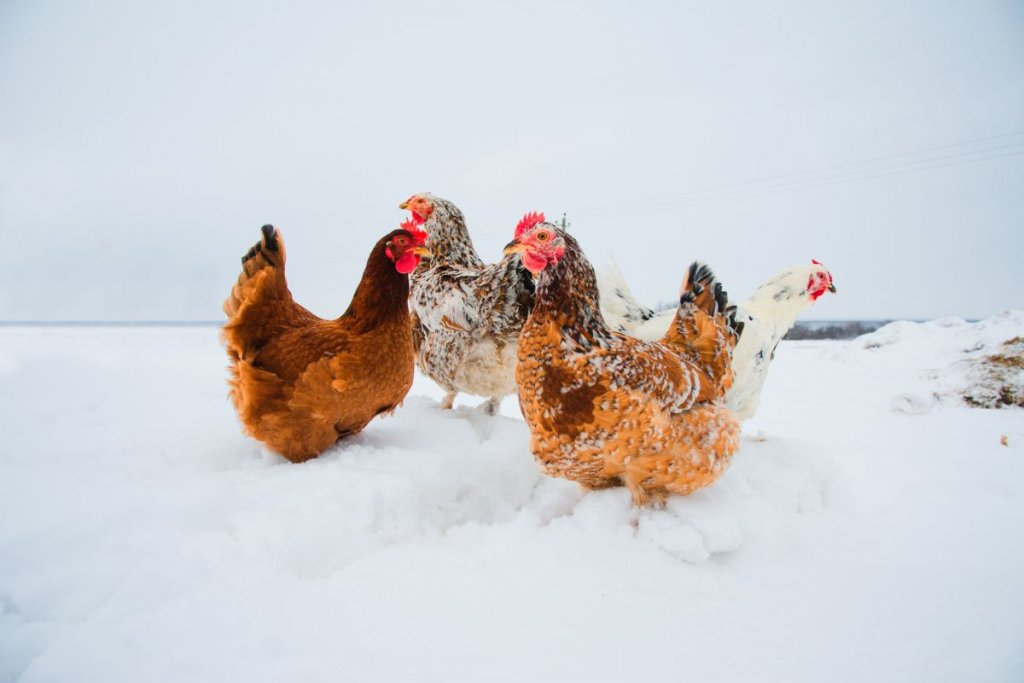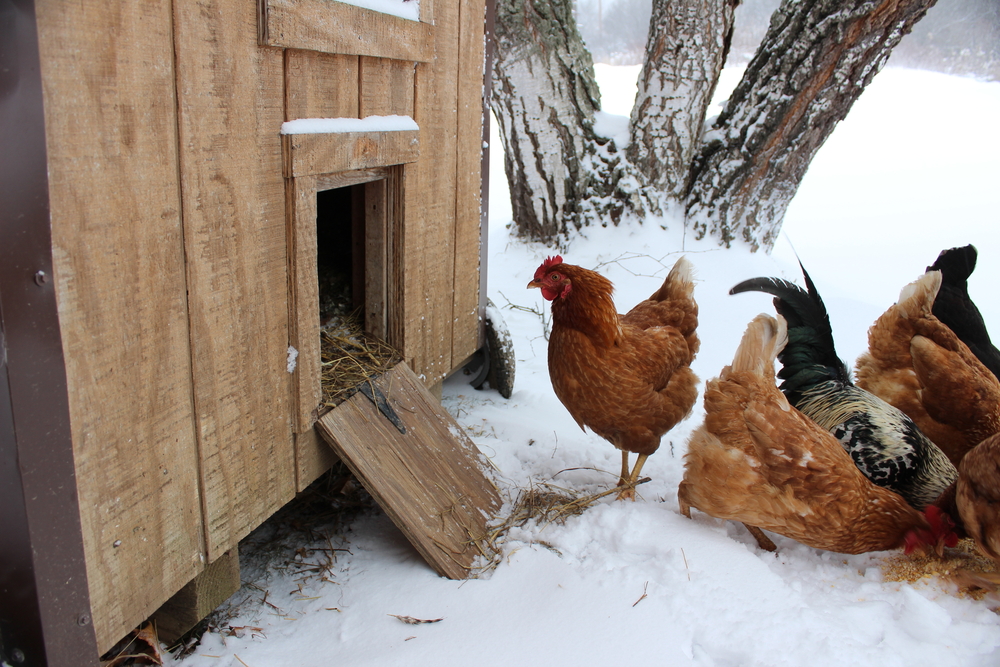There is no set temperature that is too cold for chickens. Each breed is resilient to a certain point, with some breeds being highly tolerant of the snow in Alaska and Canada. What's most important is that their chicken coop is highly insulated and you choose the right breed for your location.
Concerned about how the cold temperatures are going to affect your flock this winter? There are a variety of ways to help your flock to stay warm.
This article will cover how chickens do in cold weather and how to help them survive the winter.
Table of Contents
Different Breeds Have Different Tolerances To The Cold
The question of “how cold is too cold for chickens?” can’t be answered by giving a specific temperature. In fact, all chicken breeds react differently to the cold, so choosing a breed that will be most comfortable to your climate and ecosystem is important.
Fortunately, chickens are generally known to be able to survive in the cold and exist in some of the coldest regions of the world. For example, there are plenty of homesteads and farms in Canada or Alaska that have to endure subzero temperatures constantly and are still able to successfully keep backyard chickens.
Resilient Breeds
There are several breeds that are known for being especially cold-hardy, and those include the following breeds:
- Silkies
- Buckeyes
- Cochins
- Black Australorps
- Dorkings
- Buff Orpingtons
- Rhode Island Reds
- Wyandottes.

All of these breeds usually have heavy plumage with tight feathering that is thick enough to insulate their bodies from the cold. Many of these breeds also have smaller combs and wattles which can otherwise be prone to frostbite.
Non-resilient Breeds
Some breeds are accustomed to living in warmer climates. As you get closer to the equator, many breeds of chickens will have fewer layers of feathers so they don’t overheat in the higher temperatures. This naturally makes them less resilient to colder climates because they lack proper insulation.
Breeds that won’t normally do well in cold weather include the following:
- Sumatras
- New Hampshires
- Barred Rocks
- Brahmas
- Leghorns
- Malays
- Hollands.
A good rule of thumb is to avoid having breeds that have exceptionally large combs or wattles, as frostbite is a condition that could lead to serious long-term health issues.
Signs That Your Chickens Are Too Cold
The winter months may bring some behavioral changes that may indicate that your flock isn’t staying warm enough. Make sure to keep an eye out for any of the following:
| Signs | Common Reason |
| Sitting still and leaning over | If you notice that one of your hens is abnormally inactive and tends to slouch over, they could be trying to conserve energy as their body temperatures are too low. |
| Lack of appetite or thirst | Your chickens may stop eating food and drinking water if they become too overwhelmed by the cold. |
| Inactivity or laziness | Chickens will become overly lethargic if they are spending most of their energy trying to keep themselves warm. |
| Perching on one leg | This is a key sign to look for. If a hen is perching on just one of her legs this usually means that she’s trying to keep the other one warm. A hen should naturally be able to keep her legs warm while perching, so if it seems like she’s struggling to maintain her body heat then it’s likely too cold. |
If any or all of these signs are showing in your flock, then it is time to take action and make some changes to your current coop set up. There are plenty of simple adjustments that you can make to ensure that your flock stays warm through the winter.
Keeping Chickens Warm And Dry Within Their Coop
Start preparing your chicken coop for the winter before it comes. A well-insulated coop is the #1 factor in having your chickens survive a cold winter.
Before it gets too cold and the snow arrives, it’s a good idea to clean out your coop completely. By pulling out all of the old bedding, you’ll not only have a clean, fresh start for the winter, but you’ll also be able to search your coop for any leaks or holes that could be the source of unwanted airflow.

Be on the lookout for mouse holes, cracks, or any faulty seams in the joints of your coop’s floors and walls. These will all be subject to letting in drafts of cold air and even snow. Since you want to keep your coop as dry and warm as possible, patch all potential leaks accordingly and do a final scan of the coop before resetting the bedding in the nesting boxes.
Making sure that the coop stays pest-free through the winter is key to making sure your flock stays healthy. Spraying the coop with a mixture of vinegar, citrus, and herbs will deter mites and other parasites from moving in with your chickens for the winter.
Are Heat Lamps Necessary?
Your flock will naturally acclimate to the cold weather if they have a coop that is dry and insulated. However, it’s wise to consider a heat lamp if there’s a winter storm coming and the temperatures are dropping into the negatives.
If your flock has proved that they can take on the cold weather, it’s usually safest to wait and see if they can take on even colder weather just as well before adding a heat lamp into the equation. Heating your coop is usually a huge fire hazard, as most bedding materials are incredibly flammable.
Of course, you should consider using an additional heat source if you notice that your birds are starting to exhibit behaviors that they are too cold. If you can manage to safely set up a heat lamp or heating pads within the coop, just make sure to constantly monitor them while they’re on.
Can I Let My Chickens Out During The Winter?
It’s perfectly fine for your flock to go outside during the winter as it’s great for their health.
Venturing outside will keep your chickens active and social throughout the colder days. Having another option besides being stuck in the coop all day will prevent your flock from growing restless, as they could start fighting and pecking at one another.

When letting your flock out of the coop, follow these cold weather tips:
- Make sure you have an area that is properly cleared of snow and ice. This avoids your chickens getting wet (and avoiding bumblefoot), but the clear grounds will also allow them to more freely run around and even forage.
- Put down a layer of straw after shoveling. This will help your flock feel more comfortable when getting some fresh air.
- Apply a thin layer of Vaseline to your chickens’ wattles and combs. This is a good way to keep them protected from frostbite
- Check that your flock is dry and healthy before reentering the coop. This can prevent too much moisture and humidity from building up within their coop.
The Importance Of Food And Water
One final tip for facing the winter weather with your flock is making sure that they still get the right amount of food and water. Chickens’ eating habits should remain consistent throughout the year to encourage egg production even during colder temperatures.
Keep the amount of feed that you give them consistently as you would during the summer months. It might be tempting to give your birds an extra mealworm treat here and there to encourage them through the cold, but fattening them up will actually only risk them running into other health issues.
Their thick layers of feathers are often more than enough insulation to keep them warm.
Making sure that your chickens’ water dishes don’t freeze over during the winter can be tricky. Heated water drinkers are the easy fix, though they can be expensive and difficult to set up if you don’t have an electrical unit near your coop.
One solution is to use bowls that are made with several layers of thick plastic. This way the bowl will be better insulated and will take the ice slightly longer to fully form. When the water dishes do naturally freeze over, you’ll want to dump the ice out and refill the bowls with fresh water. Allowing your flock to always have access to fresh water and food will keep them healthy throughout the winter.

